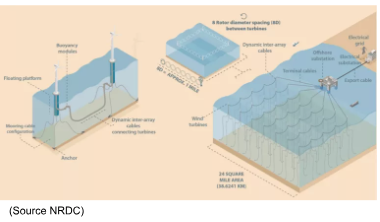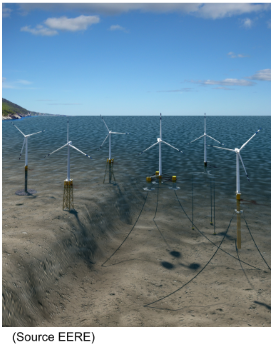Offshore Wind Turbines: What are the Advantages and Disadvantages?
The harnessing of wind power dates back to the earliest of sailboats, but how are we using it now? Wind turbines have been our most recent innovation towards renewable energy, specifically wind energy. A wind turbine is a set of blades attached to an extended base that turns the motion of the turning blades into usable energy by using natural wind (EERE). Currently, there are many shapes, sizes, types, and configurations of wind turbines, but one of the recent developments has been offshore wind farms.
An offshore wind farm, or collection of wind turbines, is anchored in a body of water off the shoreline where winds are reliable and wind speeds are faster. The depths of where they are placed can vary, but generally, the deeper you go, the stronger the wind. Stronger winds and more energy aside, there are concerns about what they could mean for the environment. We'll explore these concerns and a possible solution.
Animal Impact
Unfortunately, one of the drawbacks of wind turbines is their effect on the wildlife around them, birds especially. Since the introduction of wind turbines, bird deaths have increased. An example of this can be found in a Belgian study when the wind turbines were new. The lower turbines tended to be deadlier since 14,000 bird deaths were reported for heights 0-15 meters. That data is consistent with onshore numbers (Everaert et al. 3350). Understandably, it is crucial to understand how many birds are affected and why. Having wind turbines offshore increases the chance that many bird deaths could go unreported due to the differing environment (Brey).
As for aquatic life, the concerns are regarding added boat traffic and the extra noises and vibrations. As for any mechanism, repairs, and maintenance are expected. Unlike other wind turbines, offshore means that the only effective way to access them is by boat. Also known as vessel traffic, frequent ships in one area can be detrimental to wildlife, and the more traffic created, the more likely vessel strikes could occur. From 2010-2014 alone, there were 37 whales struck, and hundreds of sea turtles were suspected to be injured (NOAA) from all sea vessel traffic. Both of these species are endangered or vulnerable.
Additionally, many offshore wind farms operate using a fixed-bottom or a physical post that secures the turbine to the ocean floor. The overall installation process of these structures is very invasive and can cause animals to avoid the area in the long term. As a result of the unwelcoming nature of the sea, it is a lengthy construction process, and the long-term noise and vibration can cause animals to abandon an area permanently. An entire wind farm's construction would take seven to eleven years, with three to seven years dedicated to active construction or other human interference. As for size, the company that predicted the above construction time tends to have around 60-100 turbines, depending on the location (Iberdrola). Even without this, the vibrations that would inevitably emit from the turbines may interrupt communications between wildlife (NOAA).
Sustainability
It’s difficult to acknowledge that clean energy negatively impacts other important aspects of our environment. Program implementers must understand these concerns to manage, explain, and limit risk regarding public relations. Program designers should be able to explain the platform's durability, effects of corrosion, other possibilities of damage, maintenance, and innovations to protect against the harshness of the ocean.
As of 2021, news concerning deterioration of aging offshore wind turbines began to emerge. Turbines installed starting in the mid to late 1990s began to fail (Wood), suggesting a lifespan of 20-25 years. This lifespan is similar to many land-based wind turbines. While total failure is unlikely, a Nantucket offshore wind turbine failed in July 2024, and debris washed up on nearby beaches, alarming the local community and halting further construction (CNN). Investigation of whether there may have been some neglect is underway, as experts believe there should have been warning signs.
In addition to the platform element, there is also what goes on below. Some floating platforms, which are detailed more below, require anchors. The moorings, or what connects the platform to the anchors, are “chains, steel cables, or cables made of synthetic materials” (Iberdrola). Some materials could have greater risk of animal entanglement.
Structural changes
With existing technology, it is not yet possible to resolve all of the above issues, but some are preventable and innovations are introduced regularly. Long-term effects of the vibrations that the turbines generate underwater could be lessened by new anchoring systems or by installing more floating offshore wind turbines. With a floating design, there would instead be a larger platform and three anchors to keep it in place (Iberdrola).
Due to the nature of its design, the construction process for floating platforms could take place on land instead of in the water. However, there is a risk of wind and water currents which could move the turbine. Further, locations with higher winds often have more challenging conditions. Companies such as Iberdrola are studying a floating design closer to shore. Their goal is to research the viability of floating wind farms as close as 30 meters from the sea bed, where they are currently used at depths of 60 meters or deeper (Iberdrola).
Conclusion
Future blog posts will explore other environmental challenges and potential solutions as there is more that I wish to investigate. Understanding this field is important to the future of green energy which is why it is the topic I chose. These struggles and triumphs are so important for even more innovations to continue, and for us engineers to continue to solve. Please check back every few weeks for new posts or subscribe to the blog below.
About Me:
Hello, and thank you very much for reading this post! My name is Hannah Burkhardt, and I am a senior at Alexandria City High School. I am an energy and civil and environmental engineering intern at Virginia Tech’s Thinkabit Lab whenever I am exploring my engineering interests. Currently, I’m focused on researching renewable energy in the civil engineering field. Overall I'm most interested in looking into the architecture, design, and structural components of the world. My goal for this project was to explore a field that I knew very little about to aid in my growing knowledge of the engineering field.
Works Cited
Brey, Jared . “How Do Ocean Wind Turbines Affect Wildlife?” Sierraclub.org, 21 Jan. 2022, www.sierraclub.org/sierra/bird-whale-turbine-offshore-wind-science.
EERE. “Office of Energy Efficiency & Renewable Energy.” Energy.gov, 2019, www.energy.gov/eere/office-energy-efficiency-renewable-energy.
ENGIE. “How to Protect Biodiversity When Installing Offshore Wind Turbines? | ENGIE.” Engie.com, 8 Sept. 2022, www.engie.com/en/news/offshore-wind-biodiversity.
Everaert, Joris, and Eric W. Stienen. “Impact of wind turbines on birds in Zeebrugge (Belgium).” Biodiversity and Conservation in Europe, 11 Nov. 2006, pp. 103–117, https://doi.org/10.1007/978-1-4020-6865-2_8.
Fisheries, NOAA. “NOAA Fisheries.” Www.fisheries.noaa.gov, 2024, www.fisheries.noaa.gov/topic/offshore-wind-energy/protecting-marine-life.
Iberdrola. “Floating Offshore Wind Power: A Milestone to Boost Renewables through Innovation.” Iberdrola, 2023, www.iberdrola.com/innovation/floating-offshore-wind.
“The History of Wind Energy | National Grid Group.” Www.nationalgrid.com, www.nationalgrid.com/stories/energy-explained/history-wind-energy.
Kershaw, Dr. Francine. “New Recommendations Reduce Floating Wind Entanglement Risk.” Be a Force for the Future, NRDC, 2 Oct. 2022, www.nrdc.org/bio/francine-kershaw/new-recommendations-reduce-floating-wind-entanglement-risk.
Nilsen, Ella. “An ‘unusual and Rare’ Wind Turbine Failure Is Littering Nantucket Beaches with Debris, Angering Locals.” CNN, Cable News Network, 18 July 2024, www.cnn.com/2024/07/18/climate/nantucket-wind-turbine-debris/index.html.
Wood, Sam. “Aging Offshore Wind Turbines Could Stunt Growth of Renewable Energy Sector.” ScienceDaily, University of Kent, 16 Feb. 2021, www.sciencedaily.com/releases/2021/02/210216114930.htm.






No comments:
Post a Comment